We all know that antique jewelry can be quite valuable today due to the precious metal content, but what if I told you that those old vintage jewelry boxes to contain those pieces are also worth a fortune? Vintage jewelry collectors love rare caskets and trinket boxes for which they can pay thousands!
In this guide, I will explain how to identify a valuable antique jewelry box and which factors impact its value. You’ll also find some extremely rare examples that have sold for insane prices in auctions.

Identifying Valuable Antique Jewelry Boxes (6 Signs to Spot)
The history of jewelry boxes dates back to ancient times when they were made of natural materials like wood, bone, metal, and even reeds to protect precious adornments. But the design evolved with time and advancements in craftsmanship.
These changes in designs today serve as crucial tools to identify old antique jewelry boxes. Let’s understand how!
1. Design Style & Age
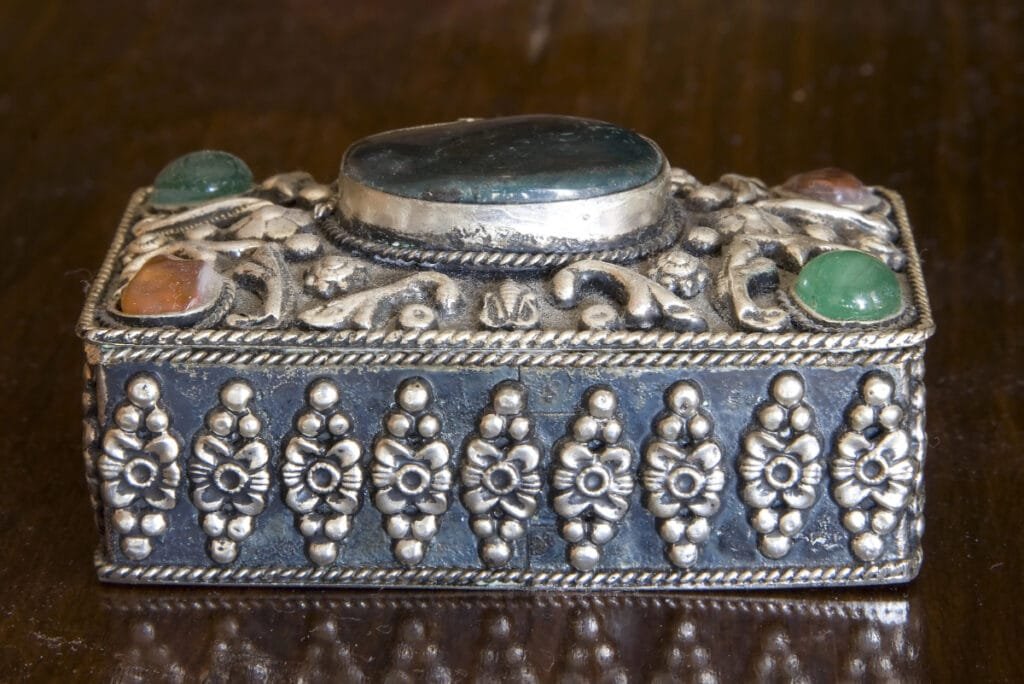
Identifying the style of a jewelry box can help you track its age and rarity. Here are the most popular antique jewelry box styles and their key identifying features:
Victorian Jewelry Box (c. 1837-1901)
Antique Victorian jewelry boxes typically feature rich, dark wood bodies like rosewood, walnut, and mahogany, often combined with luxurious fabrics like velvet and satin for linings.
Besides, Mother-of-pearl, tortoiseshell, bone, and ivory inlays, along with metal accents and hardware, were commonly used for decoration.
As for design, Victorian examples are known for their elaborate ornamentation, intricate carvings (floral motifs, scrolls, naturalistic elements), and a sense of romanticism. Look for layered designs, multiple compartments (sometimes hidden), and often a mirror.
Edwardian Jewelry Box (c. 1901-1910)
The era popularized the rise of lighter woods like satinwood and birch, often with delicate inlays of contrasting woods or mother-of-pearl. Sterling silver overlays or accents featuring pierced or engraved designs were one of the defining features, too.
The designs on Edwardian trinket boxes focus on lightness and refined details, unlike the heavy ornamentation of the Victorian examples. Clean, graceful lines, swags, garlands, and neoclassical motifs are common patterns.
Art Nouveau Jewelry Box (c. 1890-1910)
The Art Nouveau boxes typically adapt flowing, natural forms, with designs featuring stylized floral motifs (vines & leaves), insects, female figures with long flowing hair, and organic lines.
These pieces often use materials like Ormalu (electroplated gold), Silver, copper, and other metals, along with lightweight fabric for lining. For decoration, Ivory and enamelwork were prevalent. Unconventional asymmetric designs can also be found in Art Nouveau boxes.

Art Deco Jewelry Box (c. 1920-1939)
The Art Deco boxes are characterized by strong geometric shapes (zigzags, chevrons, stepped patterns), symmetry, and bold colors (black, gold, emerald green, sapphire blue). The examples appear to be largely inspired by industrial design, ancient Egyptian motifs, and jazz-age energy.
For construction, luxurious and modern materials were favored: lacquer (often in bold colors or with geometric patterns), shagreen (shark or ray skin), ivory (again, be cautious), chrome, and various polished woods. Stained glass and mirrored surfaces were also common.
The design of the boxes also became more functional, often featuring separate compartments for different types of jewelry.
Mid-Century Modern Jewelry Box (c. 1940s-1960s)
Vintage jewelry boxes from this era emphasized clean lines and functionality, without excessive ornamentation. The designs and patterns were often simple and geometric, focusing on the “Less is more” principle.
To make boxes more handy and simple, lightweight woods, like Teak, walnut, and other warm-toned woods with clean lines, became dominant. The use of Veneers was also quite common in these examples. Some rare designs may also have plastic, vinyl, or metal accents.
2. Condition
Antique jewelry boxes in good condition, free from significant damage, are generally more desirable. To assess the value, examining the overall condition of all parts, including the body, inner lining, decoration, hinges, hardware, and mechanism (e.g., musical box), is a must.
Here are some common damages to assess that can significantly reduce the value of a vintage jewelry box:
- Damaged hinges (One of the crucial value factors)
- Broken locks or clasps
- Faded or damaged linings
- Warping or splitting wood
- Tarnished or corroded metal
- Missing elements
- Water damage
Moreover, examples that come with original additional items, such as a stand, ring, and bangle roles, etc., are more valuable.
3. Material & Craftsmanship
Collectors love vintage jewelry boxes that reflect early artistry and construction. The first sign of construction is the material, and the choice of materials for both exterior and interior significantly impacts the value of a box.
Common Exterior Materials:
Old jewelry boxes feature different types of materials on the exteriors, which can indicate a lot about the box’s age as well as its value. Here’s a breakdown of the material and construction:
Woods
Common woods used in vintage jewelry boxes are:
- Mahogany: Highly prized
- Teak: Common in mid-century pieces
- Walnut: Widely used in American and European boxes
- Oak: Commonly used for light and less expensive options
- Rosewood: Highly valued in mid-century modern pieces
Exotic hardwoods like rosewood, walnut, mahogany, and exotic veneers are generally more desirable than softer woods or composite materials.
Precious Metals
Metal jewelry boxes became popular in the early 20th century, with the following metals being prevalent:
- Sterling Silver: Often marked with hallmarks indicating purity and maker
- Silver-plate: Less valuable but still attractive
- Brass: Common for hardware and decorative elements
- Ormolu (Gold-plated bronze or brass): popular in the 18th and 19th centuries
Boxes made of Sterling silver or with silver overlays and accents fetch high premiums due to the metal value and the detailed craftsmanship. Brass and other metal boxes can also be valuable if they feature a unique, intricate design.
Other Materials (for Decoration)
Vintage jewelry boxes used a wide range of materials for decoration, such as:
- Mother of Pearl: Used as inlay, especially in Victorian examples
- Tortoisehell: Used in high-quality pieces
- Porcelain: Featured in high-end boxes, sometimes hand-painted
- Ceramic: Used in Art Nouveau styles
- Bone: Used for inlay work in truly antique pieces
- Celluloid: An early plastic popular in the 1920s and 1930s
- Lacquer: Popular in Asian-inspired boxes from the 1920s-40s
- Bakelite (A type of hard plastic): Common in early to mid-20th-century examples
Boxes with leather, shagreen, mother-of-pearl, tortoiseshell, ivory, and other high-quality coverings and decorations are highly sought-after, especially if they are in good condition.
Interior Material and Construction:
- Quality Linings: Jewelry boxes with original linings, especially of velvet, silk, or high-quality satin, are highly desirable. The type and condition of these materials also impact the value of the piece. Most recent pieces generally feature felt.
- Internal Design: Though not as much, the internal design of a music box also impacts its value. For example, well-designed and intact compartments, ring rolls, and watch cushions enhance functionality and value.
The second aspect of construction is craftsmanship! Examples that reflect excellent quality vintage craftsmanship are way more collectible and valuable than those with simple, low-quality work.
Hand-carving (on wooden boxes), hand-inlaid details, and hand-painted elements are defining features of original, hand-crafted pieces. Similarly, strong joinery techniques like dovetail joints also authenticate an antique build.
Also, observe the hinges, latches, and other hardware. In rare pieces, even the hardware (mostly latches) also showcases intricate carvings, increasing their value.
4. Rarity & Unique Boxes

Generally, older jewelry boxes (over 100 years old) are typically more valuable than vintage pieces (30-100 years old). However, rarity is an even more important factor than age—a rare mid-century piece may be more valuable than a common Victorian example.
As for jewelry boxes, several factors can lead to rarity, such as limited edition examples, prototypes, or items with unique features from known makers. Also, examples especially manufactured to commemorate specific events, like Royal coronations or jubilees, etc., can be highly rare.
Apart from this, pieces with unconventional features are also considered rare. For example:
- Tramp Art Jewelry Boxes: These are vintage examples inspired by Tramp Art (American folk art), which was popular from the late 19th century until World War II. They were generally made of antique cigar boxes and featured different materials like shells, pebbles, glass, and nails, carved, layered, and glued.
- Music Box Jewelry Boxes: These are jewelry boxes but with integrated music-playing mechanisms. Reuge and Thorens are some of the most renowned makers of this type of jewelry box. The maker Sankyo is also known for making Japanese music boxes with excellent sound quality.
5. Makers & Makers’ Marks
The presence of a manufacturer’s mark on a jewelry box can reveal a lot about its origin, age, and other information. That’s why collectors typically prefer examples that bear a clear maker’s mark on the piece.
These marks may comprise the brand’s mark (name, initials, or symbol), city mark (e.g., anchor for Birmingham), date letter (varies by year), and purity mark (for precious metals).
The marks on the jewelry box can be of several types (based on the era and material):
- Stamped Marks: These are generally found on the bottom, interior, or inside the lid of the box.
- Metal plaques: These are found on premium pieces, often attached to the front or interior.
- Paper Labels: Handwritten paper labels may be affixed inside the box. In later examples, printed labels may be found. But stopping these is difficult, as most are often lost over time.
- Engraved Marks: These marks are often found on metal parts of the box or whole, solid metal boxes.
11 Rare Antique Jewelry Boxes Worth Collecting!
Below are some examples of highly collectible and rare vintage jewelry boxes that can sell for hundreds to a few thousand dollars today!
1. 19th Century Sevres Porcelain Jewelry Vanity
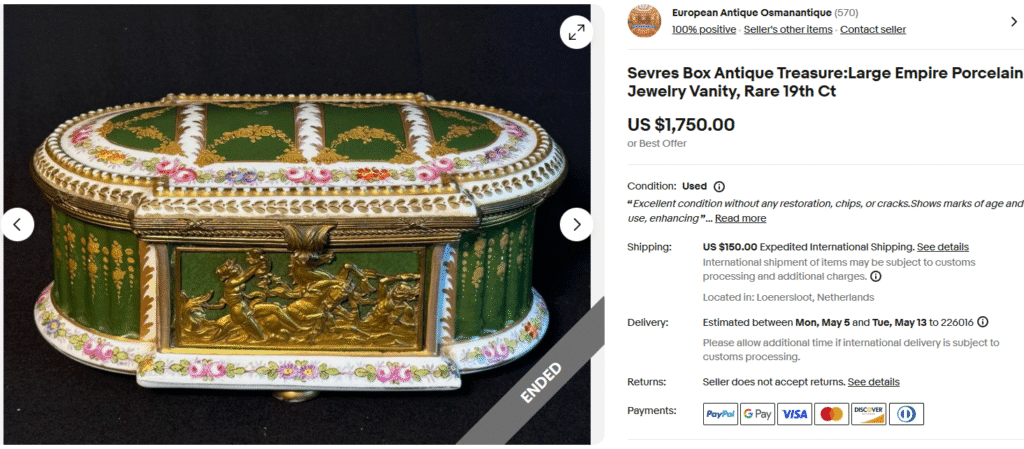
This extraordinary antique 19th-century, heavily decorated jewelry box from Sèvres is a collector’s charm. It features an oval-shaped porcelain body with elaborate gilt decorations, with an ornate lid showing decorative white panels with gold accents and a border of hand-painted pink roses and floral garlands.
The sides have beautiful gilt bronze plaques depicting a classical scene with horses/chariots in relief. The box has small decorative feet with a gilded trim and beaded borders throughout. Thanks to its ornate craftsmanship and exotic build, this box can fetch $500-$2,500 or more, based on condition.
2. Antique Tiffany Studios Bronze & Glass Grapevine Jewelry Box
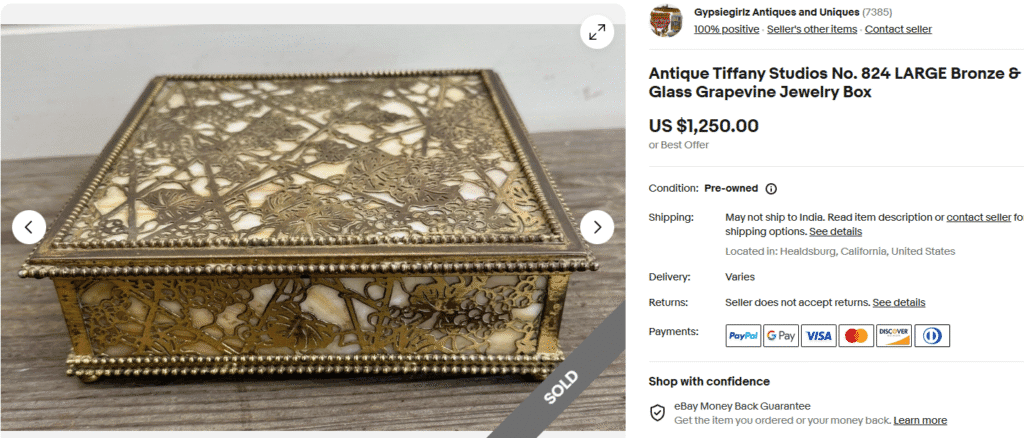
This exquisite antique Tiffany Studios jewelry box is a collector’s treasure. It’s referred to as the Model No. 824 “Grapevine” pattern, featuring an intricate bronze framework with grape vine and leaf motifs and decorative beaded borders along the edges of the lid and base.
The bronze framework opens to showcase panels of creamy/ivory colored glass or stone inside the lid as well as the box. The bottom of the box reveals the engraved “Tiffany Studios/New York/824” marking.
This vintage jewelry box exemplifies Tiffany Studio’s signature style with its organic grapevine design and the combination of bronze and glass, making it highly collectible. The value can range from $800 to $2,000+ in good condition.
3. Lalique Glass and Metal Jewelry Box
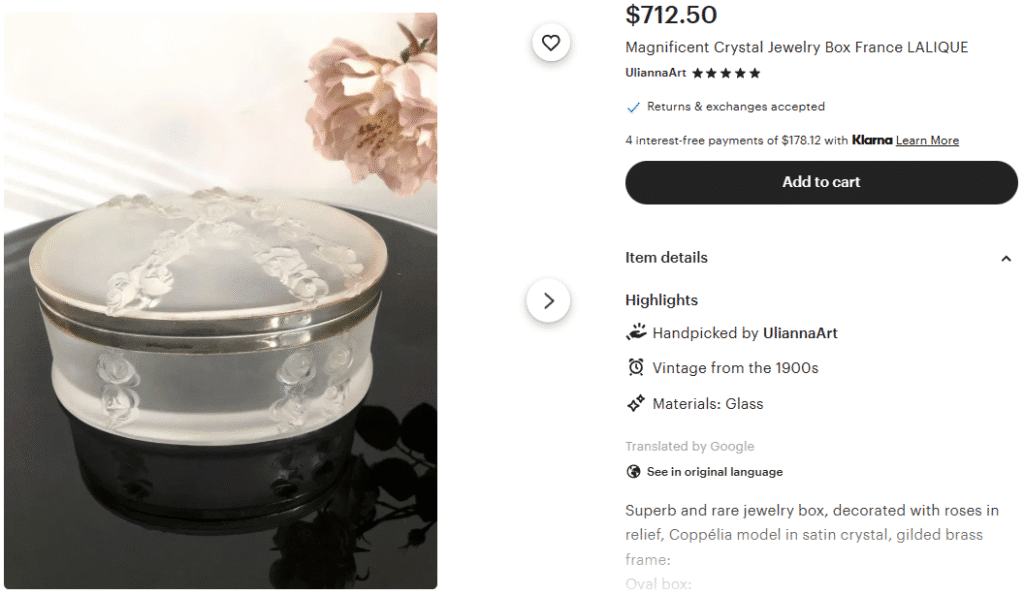
This is a sleek and beautiful crystal jewelry box from Lalique dating to the early 1900s. It has a delicate frosted crystal body featuring roses in relief around the sides and lid with a gilded brass metal frame/rim.
This jewelry box characterizes Lalique’s signature technique of combining frosted and clear glass with delicate relief work, making it a collector’s gem.
4. Antique Murano Opaline Glass Casket Jewelry Box

This is a unique casket-style Murano jewelry box made of vibrant green opaline glass. It’s a simple and elegant piece featuring a gilt metal rim with decorative borders on the box and the lid. The rare green opaline glass and giltwork can make this box worth $500-$1,500 or more in excellent condition.
5. Vintage Louis Vuitton Boite-Bijoux Jewelry Case

This classic LV jewelry box is highly collectible. It’s a vintage-style rectangular box with a lift-up lid. The whole box features the iconic Louis Vuitton monogram canvas with leather trim and a golden front clasp closure.
This LV classic piece can easily fetch $600-$1,500, depending on the condition.
6. Tartan Ware ‘Buchanan’ Victorian Jewelry Box
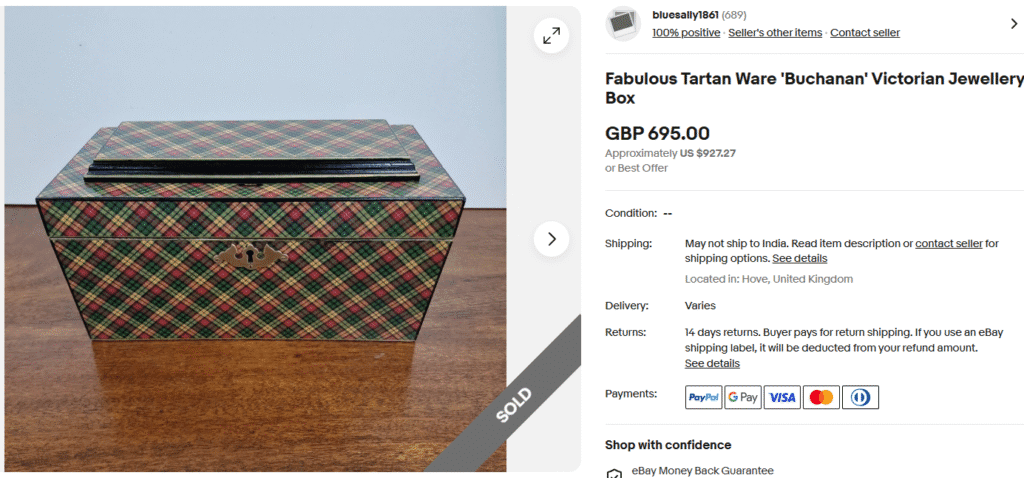
This rare 1880s Victorian jewelry box is covered in the Buchanan clan tartan pattern featuring a colorful plaid design in red, green, yellow, and black. This style is specifically known as “Mauchline Ware” or “Tartan Ware,” named after a production center in Scotland.
It features a hinged lid and a keyhole escutcheon on the front. There’s also a small nametag, with “McBeth” written on it. The box has well-designed compartments. Bunchana Tartan jewelry boxes in good condition can fetch $600-$1,200.
7. Baccarat Charles Cut Glass Crystal Casket Jewelry Box
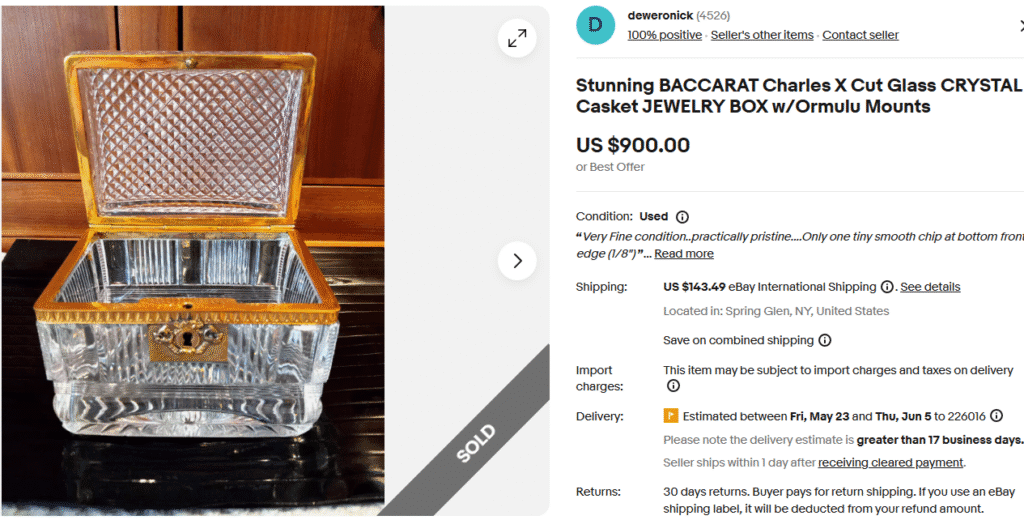
This is a high-quality cut crystal jewelry box by the prestigious Baccarat glassworks of France, made for Charles Mayer & Co. It’s a rectangular box with a hinged lid and intricate diamond-cut pattern on the lid interior that opens to reveal a fully mirrored interior.
The sides show beautiful vertical cut patterns and additional decorative cutting. The edges of the lid and box are decorated with ormolu (gilt bronze) mountings and a decorative escutcheon/lock. In excellent condition, this vintage jewelry box can be worth $500-$1,500 or more.
8. Sevres Chateau Des Tuileries Blue Jewelry Box
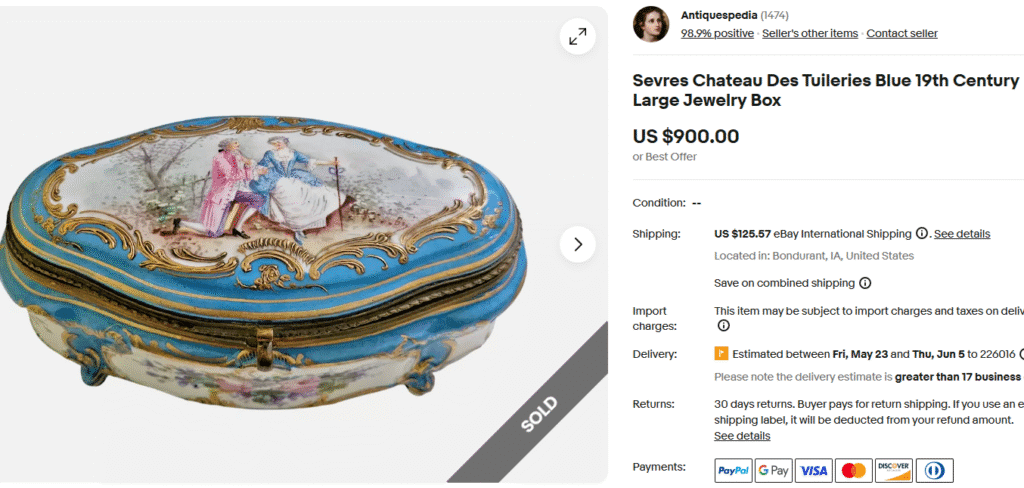
This is an exquisite antique Sèvres porcelain jewelry box, described as a “Chateau Des Tuileries” piece, suggesting a connection to the famous Tuileries Palace in Paris. It features the distinctive “Bleu de Sèvres” (Sèvres blue) color on the lid and sides.
The lid has a beautiful hand-painted romantic scene depicting an elegantly dressed couple in 18th-century attire with elaborate gilt/gold decorative borders and rococo-style scrollwork frame. The box generally stands on four small feet and has a metal clasp at the front.
The hand-painted design and porcelain body make this antique jewelry box highly collectible, justifying a value of $600-$1,800 or more.
9. Islamic Antiquity Old Safavid Era Beautiful Jewelry Box
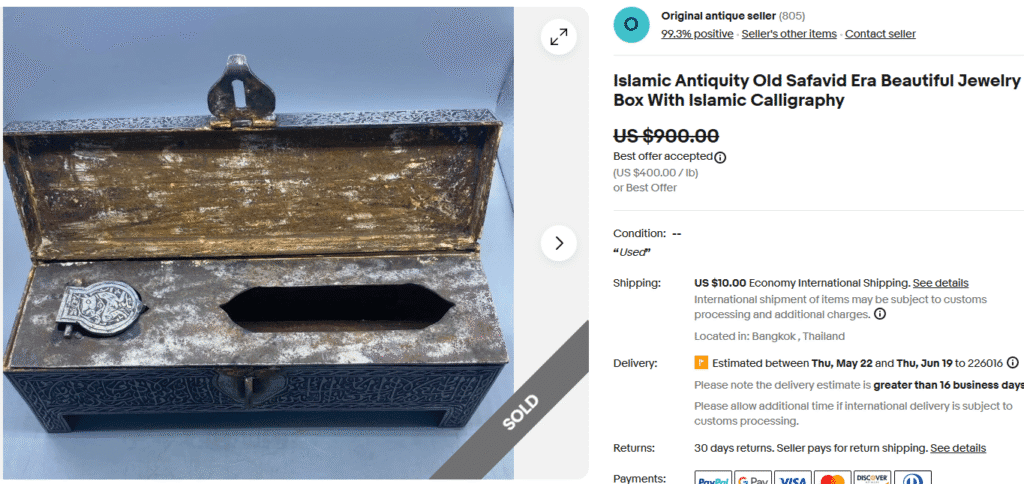
This rare and fascinating Islamic jewelry box dates back to the Safavid Era (approximately 1501-1736). A real antique piece! It’s made of metal (possibly brass or bronze) with detailed Islamic calligraphy engraved around the exterior.
The rectangular box features a hinged lid that appears to be lined with gilt material. The interior shows compartments, with what appears to be an inkwell or small container visible on the left side. This is an extremely rare example that can easily fetch up to $1,500, depending on the condition.
10. Vintage “Mexico” Sterling Silver Footed Trinket/Jewelry Box

This is an elegant vintage Mexican sterling silver jewelry box featuring a rectangular design with decorative “bun feet” supporting the base. It showcases a beautiful ornate scrollwork border around the perimeter.
The top surface has raised, polished, dome-shaped decorative elements arranged around the border. The bottom of the box likely has an engraved “Sterling/Mexico” mark, indicating that it’s made of sterling silver, likely hand-crafted in Mexico.
11. Vintage Swiss Reuge Dancing Ballerina Musical Jewelry Box
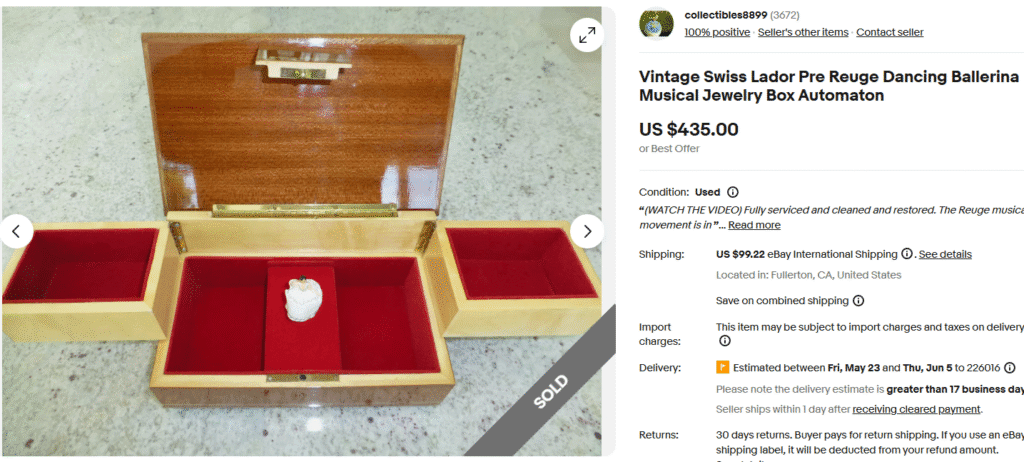
This is a rare and unique jewelry box that is also a music box. This stunning example is from Reuge, a prestigious Swiss manufacturer, featuring a musical mechanism with a pre-Reuge Lador movement.
The highly polished wooden box features a dancing ballerina automaton that spins when it’s opened. There is a flawless multi-compartment interior with bright red velvet lining, with the central section containing the ballerina figurine.
With all hardware and music mechanisms working, this music jewelry box can fetch $300 to $800 or more.
